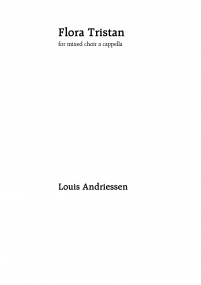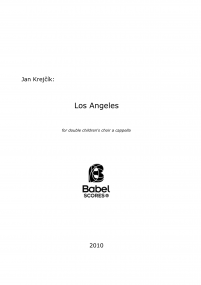Kalevi Matus
ISMN : 979-0-2325-1199-3
- Login to create your own lists
CAT# (YEAR COMPOSED): 58 (2001)
INSTRUMENTATION: for choir and optional children’s chorus
PAGES: 29pp
DURATION (APPROX): 14’00
PREMIERE PERFORMANCE: Partial premiere was given in October 2000 in Rame Küla, Estonia. A second partial premiere was given by the Choir of the HdK (Berlin), Miriam Sohor, conductor at the SchlossPark in Potsdam, Germany in 2001.
NOTE: Kalevi Matus was Semifinalist in the Composition Contest of the Netherlands Radio Choir, 2007
NOTE 2: Dedicated to Marika Blossfeldt, Artistic Director of Polli Talu Arts Center, an International Residential Center in Rame Küla (Estonia), where Kalevi Matus was conceived and composed in September to October 2000.
NOTE 3: Pencil drawing on cover by Kristjan Raud (1865-1943), “Linda kive kandmas” (ca. 1935)
Kalevi Matus is a series of six short choral movements with optional interludes. The text of Kalevi Matus is an episode of the Estonian national epic Kalevipoeg (Meaning son of Kalev). In this story, Linda, Kalevís widow is mourning her husbandís death and is carrying large stones to build a monument on his grave. At the time, Linda is pregnant with Kalevipoeg, the heroic figure of the epic. Weak from her condition, she drops a large stone. Unable to pick it up, she sits down on the stone and begins to cry. Her tears form a little puddle, which turn into a pond, and then into a lake. Today, you can still see Lindaís large stone in the middle of her tear lake (‹lemiste lake) in Tallinn.
Kalevi Matus was designed for an amateur group, and continue a personal exploration of heightened developments of sound production and organization. As might be expected, certain compromises had to be accommodated in the rhythmic and pitch axes for an amateur group, but did allow for explorations of airflow, source, resonance, articulation and multiphonic production.
Specifically, each movement looks towards differing aspects:
Movement one:
The opening texture examines timbre as produced by the vocal fold source, the timbre is aggressive, bright, forward, nasal, brassy. This timbre is crucial to telling the story and to what follows. As a by-product of this sound, certain words are followed by a formant glide from /a/ or /e/ towards and /i/. This results in the dominant formant (specifically F2) raising in frequency and which will slightly reinforce the underlying harmonics, when combined with this special vocal timbre. Page two features a contrast of production by offering a deep, dark and backward placement, before a return to the opening timbre and tempo. The next section features a solo influenced by music of the Settu communities of southern Estonia that intermingles with material of the opening to end the movement.
Movement two:
This entire movement is characterized by a rapid amplitude and pitch gain with a relatively lengthy decay. The voices will both synchronize and non-synchronize their movements
Movement three:
Beginning with a sober narration, this movement features an increasingly dramatic rendition of Linda’s plight. The narration is done by a solo bass voice, with the chorus providing a sound environment of frications produced according to the palatal mapping. Gradually the chorus becomes prominent and explores filtering of the palatal space, through unvoiced pitch productions. This is followed by the narrator reentering in a dramatic fashion and accompanied by the chorus who are producing complex and changing, voiced nasal filters.
Movement four:
This movement begins with a children’s chorus offstage, singing the traditional Estonian folk tune “Mu Süda, Ärka Üles” in a four-part chorale harmonization at largo. Then in presto, a three-part women’s divisi elaborates upon the tune, beginning as a canon and then a canon out-of-control, as in the next section on page 11, the three parts are in different tempi with six different melodic formuli to sing with and against the other parts. Finally, this movement ends with a bass solo singing another traditional folk tune “Ma Annan Oma Südame” in d minor, over which the chorus are softly holding extremely complicated, non-tonal harmonies, utilizing three-part complex filters.
Movement five:
A motive c, b a-flat and g runs throughout this movement – harmonically and melodically. A solo woman’s voice sings powerful expressions characterized by rapid glottal stops, diaphragm pulsations, registral flips and featuring a strong, brassy timbre. The choir both supports and interrupts the soloist. On page 14, the chorus uses a complex filter and source mechanism when applying a sustained stop with location indicated by palatal mapping that are articulated on a pitch by the diaphragm pulses. Over this the soloist combines her melody and text with frications indicated again by the mapping system. This produces voiced and unvoiced multiphonics.
Movement six:
This last movement is reminiscent of the first movement with the addition of a more complicated rhythmic framework. Additionally, florid vocalization passages are included as a wink to the sickening practice of tone painting. Within this texture are found elements of the first movement embedded. Gradually the movement becomes intensified and closes with a nod to the opening of the entire collection of Kalevi Matus.
Pages - 36














 copia_285x285.png)